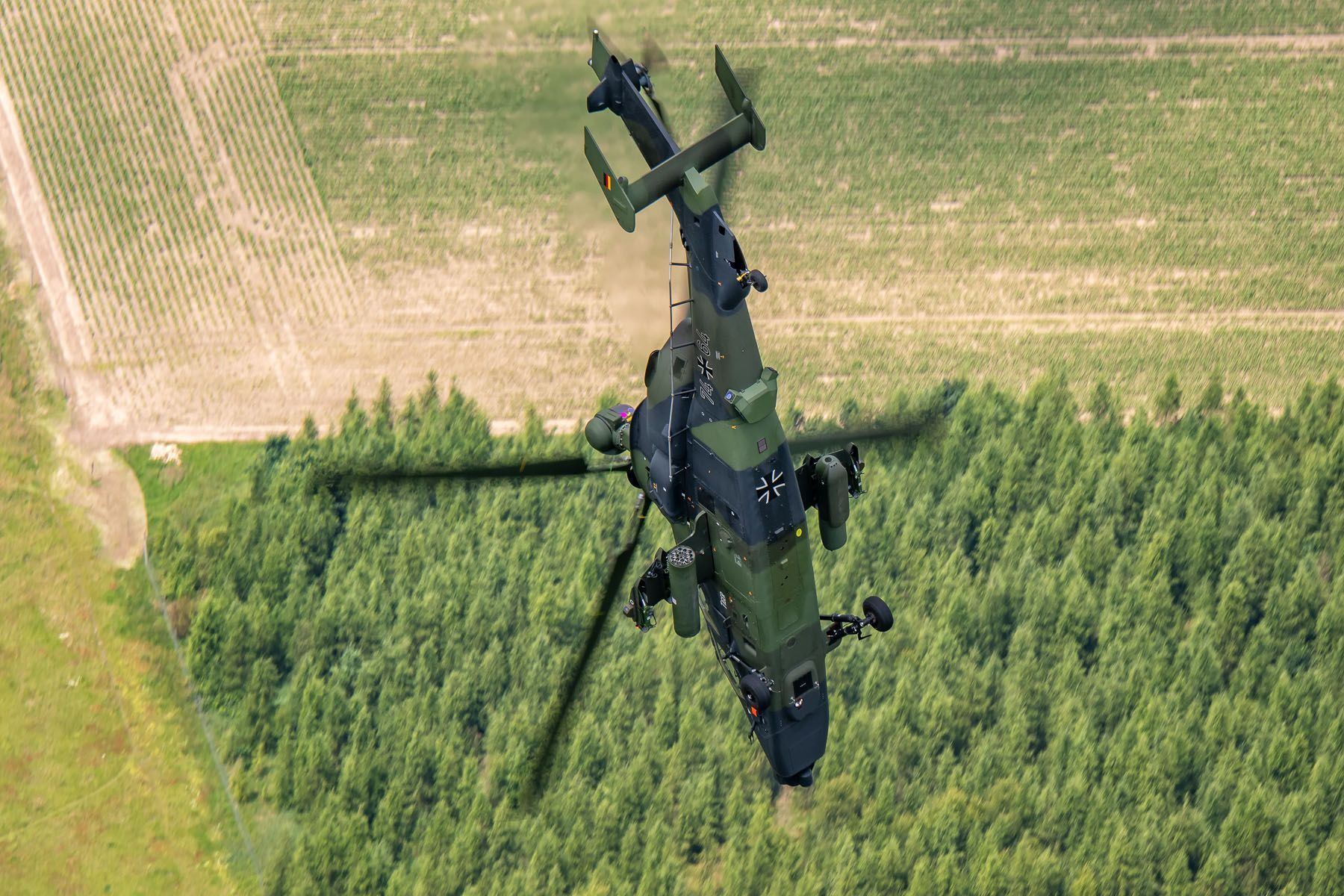In 2024, Germany decided to retire their fleet of Tiger attack helicopters earlier than planned and to replace the type with an interim solution, the multi-purpose Airbus Helicopters H145M. During its relatively short career with the German Army, the helicopter faced many challenges and never seemed to fully meet its demands. But will the new helicopters do? Let’s have a closer look into the project.
Text and photos: Emiel Sloot
1 July 2025
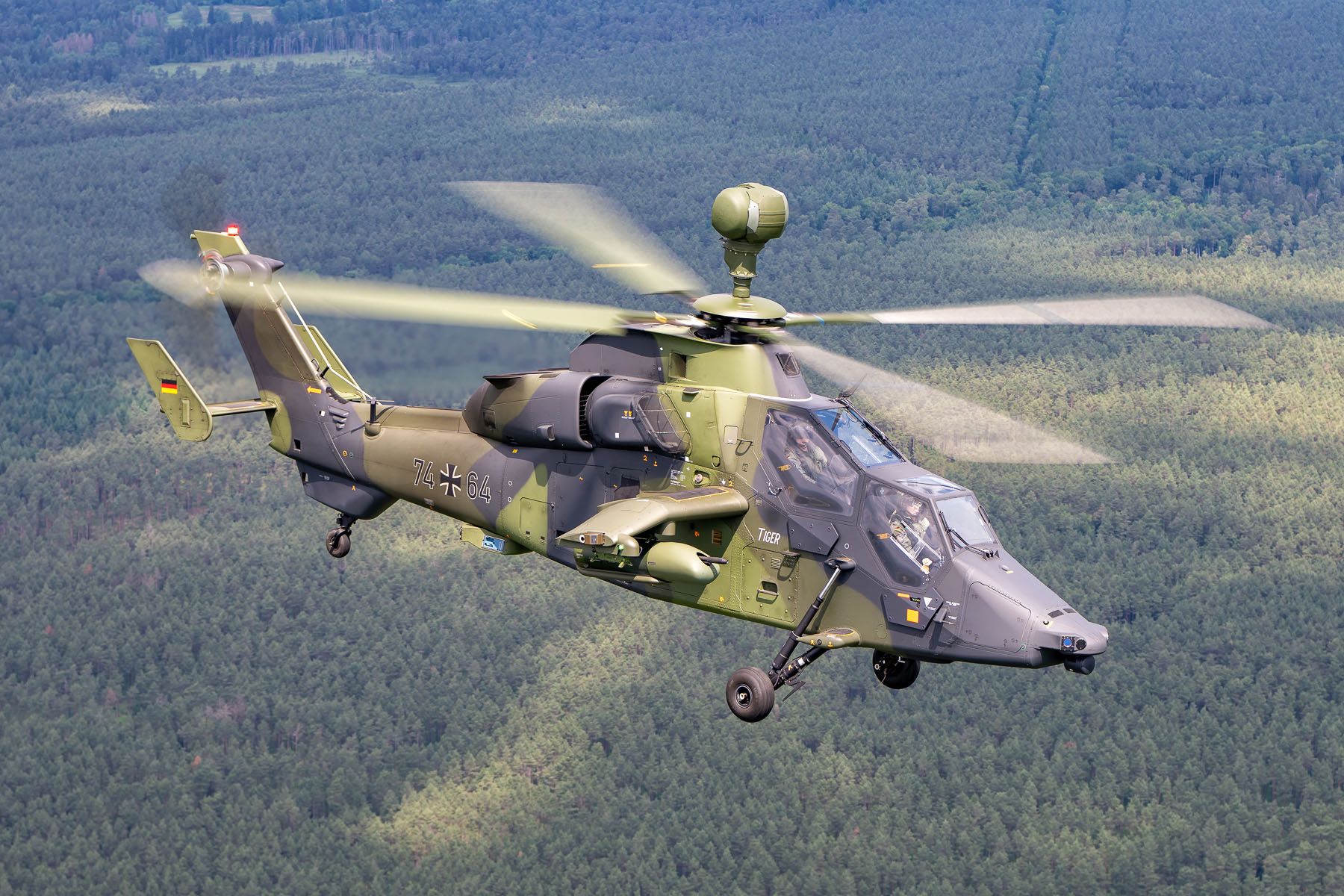
A Tiger Story
During the last years of the Cold War, the Heeresflieger (German Army Aviation) was well equipped with anti-armour helicopters. Dubbed the Panzer Abwehr Hubschrauber (PAH), a total of 212 MBB/Bölkow 105P had been ordered for use with three regiments. The Bo 105 was basically a light and very manoeuvrable helicopter converted for the job, and the Heeresflieger was keen to replace these with a dedicated anti-tank platform. Known originally as PAH 2, this resulted in the development of the Eurocopter EC 665 Tiger. But as mentioned, it could apparently never reach its goals to a satisfying level, and therefore the German Army has now selected a successor: the Airbus Helicopters H145M LKH, a light and very manoeuvrable helicopter converted for the job. The circle is round.
Development
Tiger development traces back all the way to 1984. The West-German and French governments established a list of requirements for a future anti-tank helicopter to equip the armed forces, destined to replace their Bo 105s and SA 342 Gazelles in that role, respectively. A joint venture between MBB and Aérospatiale was foreseen to develop and built the new helicopter. High costs initially delayed the project and it was not until November 1989 that an order for five prototypes was issued by the two countries - coincidentally, during the very same month the Berlin Wall fell. The helicopter would be powered by a pair of new MTR390-2C engines, developed and built by the MTU Turbomeca Rolls-Royce consortium, or MTR GmbH, located at Hallbergmoos in Bavaria, Germany.
The disappearance of Germany’s inner border and the subsequent joining of both countries would soon have an effect on several defence projects, including the new helicopter. The concept of a pure dedicated anti-armour helicopter as laid down in PAH 2 was adapted into a more multi-role platform, able to carry out armed escort missions in support of the army alongside its original role.
The first prototype went airborne for its maiden flight fairly quickly following the start of the programme. On 27 April 1991, the French-built PT1 flew from the Eurocopter factory location in Marignane near Marseille. Of the five prototypes, two were allocated to the German programme partner. PT3 (serialled 98+23) first flew on 19 November 1993 and was involved in the testing of the full avionics suite, including autopilot and navigation systems. When its testing career was done, the airframe was initially used from ground instructional purposes at the army helicopter base at Fassberg. Subsequently, PT3 transferred to the Hubschrauber Museum Bückeburg where it is currently on display. German testbed PT5 (98+25) went airborne on 21 February 1996. Equipped with the full avionics package, PT5 was used for weapons testing such as Stinger anti-aircraft missiles, HOT-2 anti-armour missiles and a 12.7mm gun pod. PT5 also featured the characteristic Osiris sensor attached on top of the rotor head. It made its final flight on 22 July 2004 and continued to serve as ground instructional airframe at Fassberg.
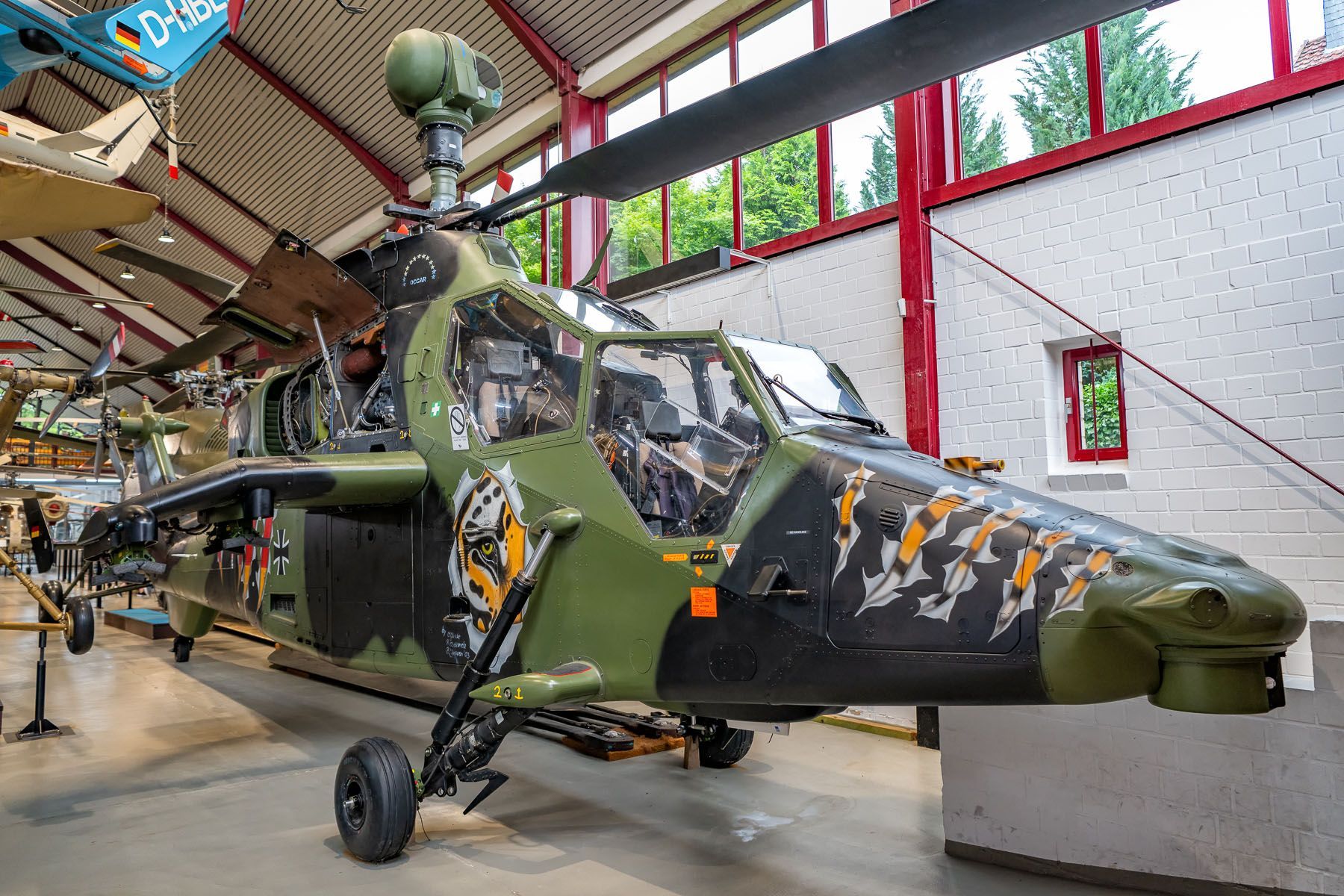
Systems and armament
In the tandem-seat Tiger, the pilot is seated in the front with the weapon systems operator in the aft position. The cabin climate control protects the crew in an NBC (nuclear, biological, chemical) environment. While aluminium and titanium alloys are used for certain key parts, some 80 percent of the fuselage is constructed with composite materials, reducing both weight and its radar signature. Regarding the latter, the matt camouflage paint contributes to this feature, as is the way the front silhouette was designed with minimal curvature. The fuselage contains a grid of copper and bronze to protect against lightning strikes and EMP (electromagnetic pulse). The pilots wear the BAe Systems Knight helmet, and the FLIR infrared sensor mounted underneath the helicopter’s chin can be coupled to the helmet’s sight to assist with operation in darkness.
The Tiger can strike enemy ground targets in all weather, day and night. It is equipped with four hardpoints on its stub wings – two on each side. Specifically for the Heeresflieger examples, the choice of available weapons is as follows: a maximum of two FN-Herstal HMP 400 pods can be carried on the inner stations, each containing a M3P 12.7mm heavy machine gun with 400 rounds. Two Thales Belgium FZ225 launchers with up to 19 unguided 70mm rockets can be fitted to either inner or outer hardpoint. These rockets feature high-explosive heads to counter light armoured vehicles or similar ‘soft’ threats up to a range of 6km. The inner hardpoints can also be used to carry four MBDA Germany PARS 3 LR (PanzerAbwehr RaketenSystem 3rd Generation Long Range) anti-armour missiles each. This weapon has a range of 7km and is initially directed by the helicopter, whereafter the passive IR sensor in the missile takes over. In this ‘fire-and-forget’ setup, the crew can immediately take cover after the launch. The missile can be used against ground or air targets such as enemy helicopters, in either direct attack mode or alternatively in top-attack. If needed, a salvo of up to four can be fired within eight seconds. A total of 680 PARS 3 LR missiles were ordered by Germany on 30 June 2006 in a contract worth €380 million, with deliveries starting in 2012. The PARS 3 LR was meant to succeed the older Euromissile HOT-3 system, however these missiles are still available as well until at least 2027. Which is a good thing, as firing trials with the PARS 3 LR in the USA in 2018 were reported to be unsatisfactory, with about half of the ordered missiles already being delivered.
For self defence, it can carry two Raytheon ATAS (Air-to-Air Stinger) missiles on its outer stations.
Other self protection measures include the Hensoldt AN/AAR-60 MILDS (Missile Launch Detection Sensors), providing a 360-degrees coverage by a number of ultra-violet sensors detecting incoming infrared-guided missiles. The Thales Threat Warning Equipment warns the crew against enemy radars and laser-guided weapons. It can automatically active the Saphir-M flare system that contains ten containers with 18 till 72 decoys each.
The Tiger is powered by a pair of MTU/Turbomeca/Rolls-Royce MTR390-2C power plants. An auxiliary power unit (APU) is used to start the engines. The intakes are shielded to protect the engines against foreign object damage (FOD). The engines are digitally controlled and protected by Full Authority Digital Engine Control (FADEC). The two power plants each produce 958kW/1.303hp; the upgraded MTR390-E for hot-and-high operations even reach 1.094kW/1.487hp, however German Tigers are not modified with these. The fuel tanks supplying the engines are self sealing.
The four fibre composite rotor blades are resistant against machine gun fire and bird strikes, and can be fully folded to enable transport by air and sea. On top of the main rotor mast sits Osiris, a sensor that enables observation of the battlefield from a covered position such as a tree line. Osiris is developed by Sagem and features both infrared and CCD digital video, a laser rangefinder and a tracking device for the older HOT-3 missile system. Osiris can be coupled to the crew’s Knight helmet to follow its movements.
In view of avionics, the Tiger features an autopilot system, and for position awareness it can reply on GPS, two Thales ring laser gyros and a CMA-2012 Doppler radar. The latter two independent systems have become increasingly significant in today’s battlefield due to frequent GPS jamming and spoofing. The Tiger is Link 16 capable for data transfer between other friendly assets.
To conclude, some performance data on the Tiger: it can reach a maximum speed of 145kts (268kmh), and with an endurance of 2:30hrs it has a maximum range of 390NM (725km). Its maximum take-off weight is 6,100kg.
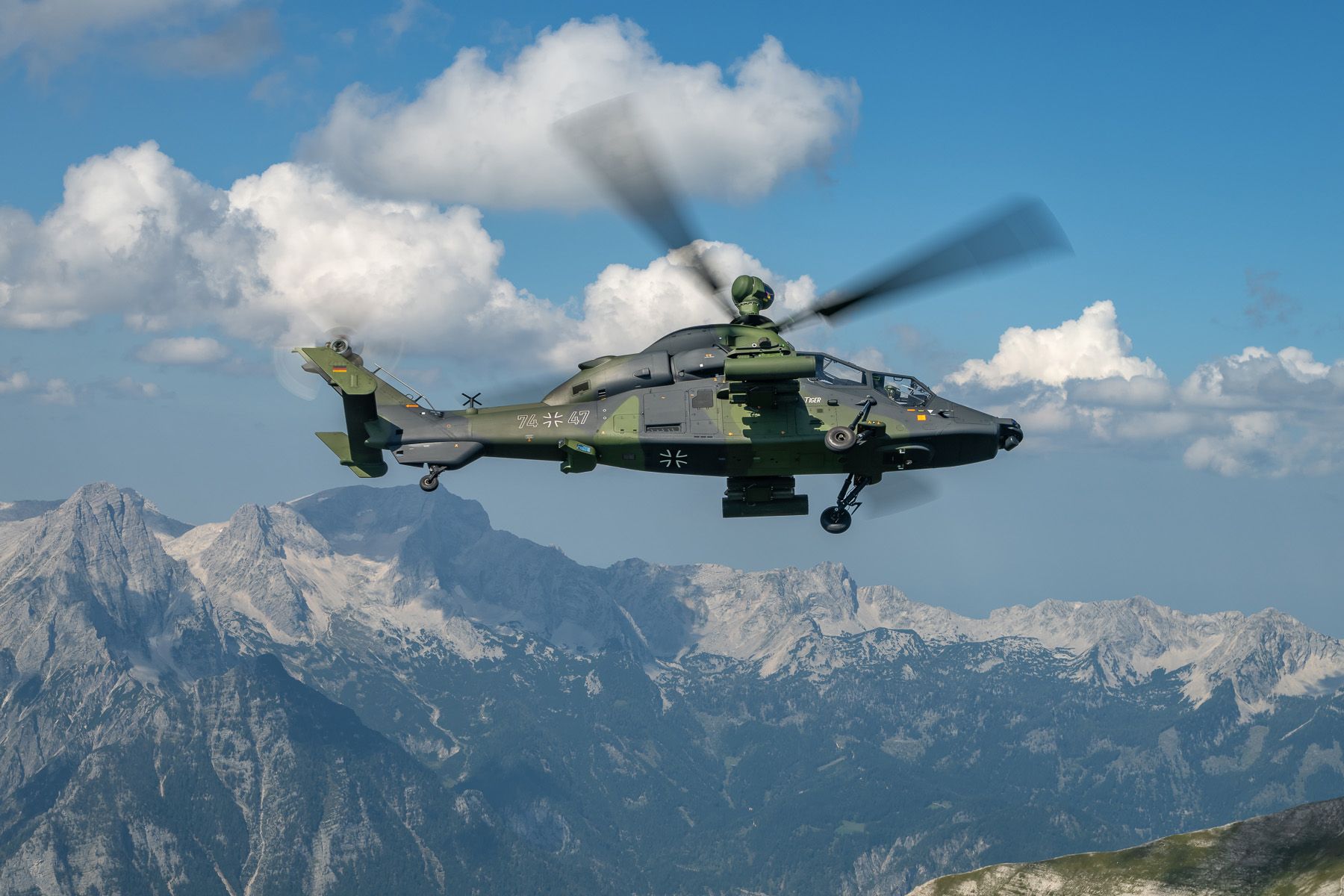
Deliveries in STEPs
On 18 June 1999, Germany ordered 80 Tigers (airframe serials 1001-1080) in the Unterstützungshubschrauber Tiger (UHT) variant. Initially planned to equip two operational regiments, eventually only one of the latter received the new type, as did a bi-national training centre. The various parts of the helicopters were built at different locations, and at four final assembly lines the pieces were put together for their respective customers. As such, the German examples rolled off the production line at Airbus Helicopters in Donauwörth.
Following extensive acceptance tests, the first one was handed over to the Bundeswehr (German Armed Forces) on 6 April 2005. Most of the initial production batch were delivered in the so-called STEP 1 standard, configured for air and ground training but lacking combat capabilities. With airframe 1003 used for ground instructional at Fassberg, five (1005 to 1009) joined the joint French/German Tiger crew training unit at Le Luc-Le Cannet in southern France. The armed force’s test and evaluation unit WTD 61 (Wehrtechnische Dienststelle 61) at Manching closely examined airframe 1001 (then serialled 98+26).
Meanwhile, airframes 1002, 1004 and 1010 were completed in the STEP 2 standard, in preparation of the more advanced STEP 2 GCOM, also referred to as STEP 2 KRYPO or STEP 3. The second batch consisting of 1011 to 1015 were also STEP 2 Tigers, capable of deploying weapons but lacking certain communications such as HF radios as well as datalink. Further certification for the UHT STEP 2 and STEP 2 GCOM versions was issued on 29 December 2008. The older STEP 1s were subsequently upgraded to STEP 2, since parts would be no longer available for the older version beyond 2009. From airframe 1016, Tigers would be delivered in the STEP 2 GCOM configuration, thus including the full radio suite and datalink.
The readiness of the helicopter turned out to be suboptimal in the early days of operation. One of the main issues was a problem with the internal wiring. This particularly concerned chafing on the cable sheath as well as partly on the cables themselves. While the French solved this by redirecting the cables, the Germans decided to use more robust cable sets. The first two rewired Tigers were handed over to the Heeresflieger in July 2010 for testing.
The lack of a chin-mounted large-calibre cannon was also criticized. Although the Bundeswehr defended this decision by stating that the UHT’s weapons suite enabled the helicopter to fulfil all intended tasks, the fixed cannon pods – of lesser calibre than the nose-mounted version – means the pilot has to manoeuvre precisely to direct the ammunition. This has a negative effect on its self protection as it costs more time to do, rather than quickly just aim the cannon. And, in hindsight, a quickly moveable gun would be much more effective against drones over today’s battlefield.
During early 2011, the type certification for the UHT was issued by the German Luftfahrt Bundesamt. This allowed the helicopters to be put on the regular military register, and the allocated serial range (74+01/80) could now be applied instead of the 98+xx range.
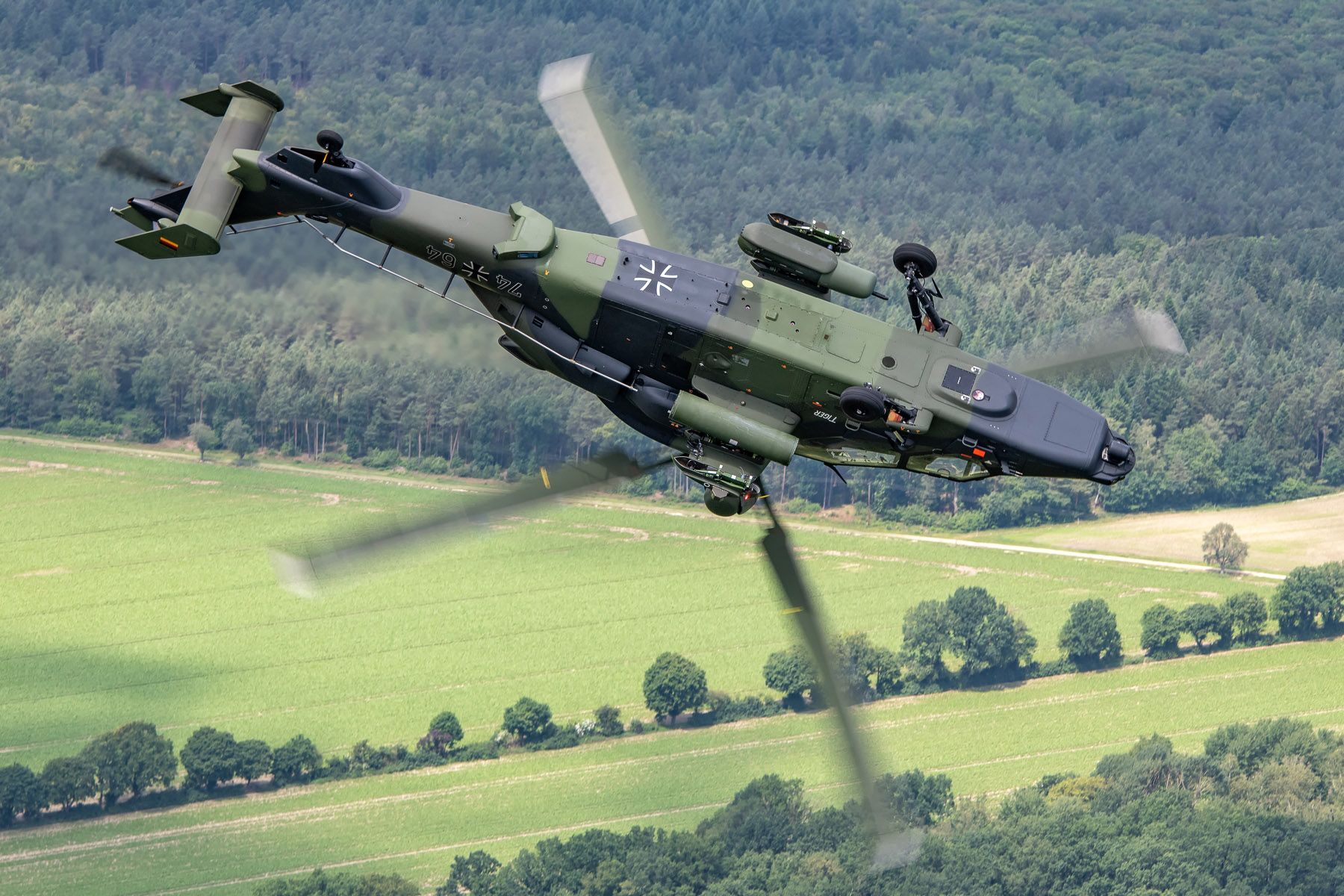
ASGARD
Germany planned to deploy a few UHT helicopters to Afghanistan in support of NATO’s International Security Assistance Force (ISAF) mission from around 2010, but the wiring issue had already delayed this deployment. However, to prepare for this operation, an adapted UHT variant called ASGARD (Afghanistan Stabilization German Army Rapid Deployment) was already created. Airframe 98+26 (c/n 1001) was configured as a testbed. ASGARD would come in two slightly different variants: ASGARD-F is the fully operational version, featuring additional armour for protection; sand filters for desert operations; SATCOM and tactical radios; TACAN antenna; a shooting camera; improved missile launch detector; and an electronic warfare system and library. ASGARD-T is a version for training purposes, with an interim shooting camera and an equipment kit for external lighting. It was also foreseen to equip ASGARD with upratedMTR390-E engines, suited for hot-and-high operations by delivering 14 percent more power. However, this was not to be, as the Bundesamt für Wehrtechnik und Beschaffung (Federal Office for Military Equipment and Procurement) felt that the standard engines were sufficiently suited for that task.
Twelve Tigers were then converted to ASGARD following a procurement order signed late 2011, 74+24 being the first one to be redelivered. To prepare for the upcoming ISAF deployment, two ASGARD-Fs operated from Holloman, NM in June 2012 for a test and evaluation programme during exercise Falcor 2012. The Afghanistan deployment for the Tigers commenced in December that year, while the last of the twelve initial ASGARD conversions re-entered operational service with Kampfhubschrauberregiment 36 at Fritzlar on 6 March 2014. Because 74+27 was lost in an accident in 2013 (more on that later), ASGARD prototype 74+01 temporarily joined KHR 36 until 74+36 was converted to ASGARD-T ultimately replacing the crashed example.
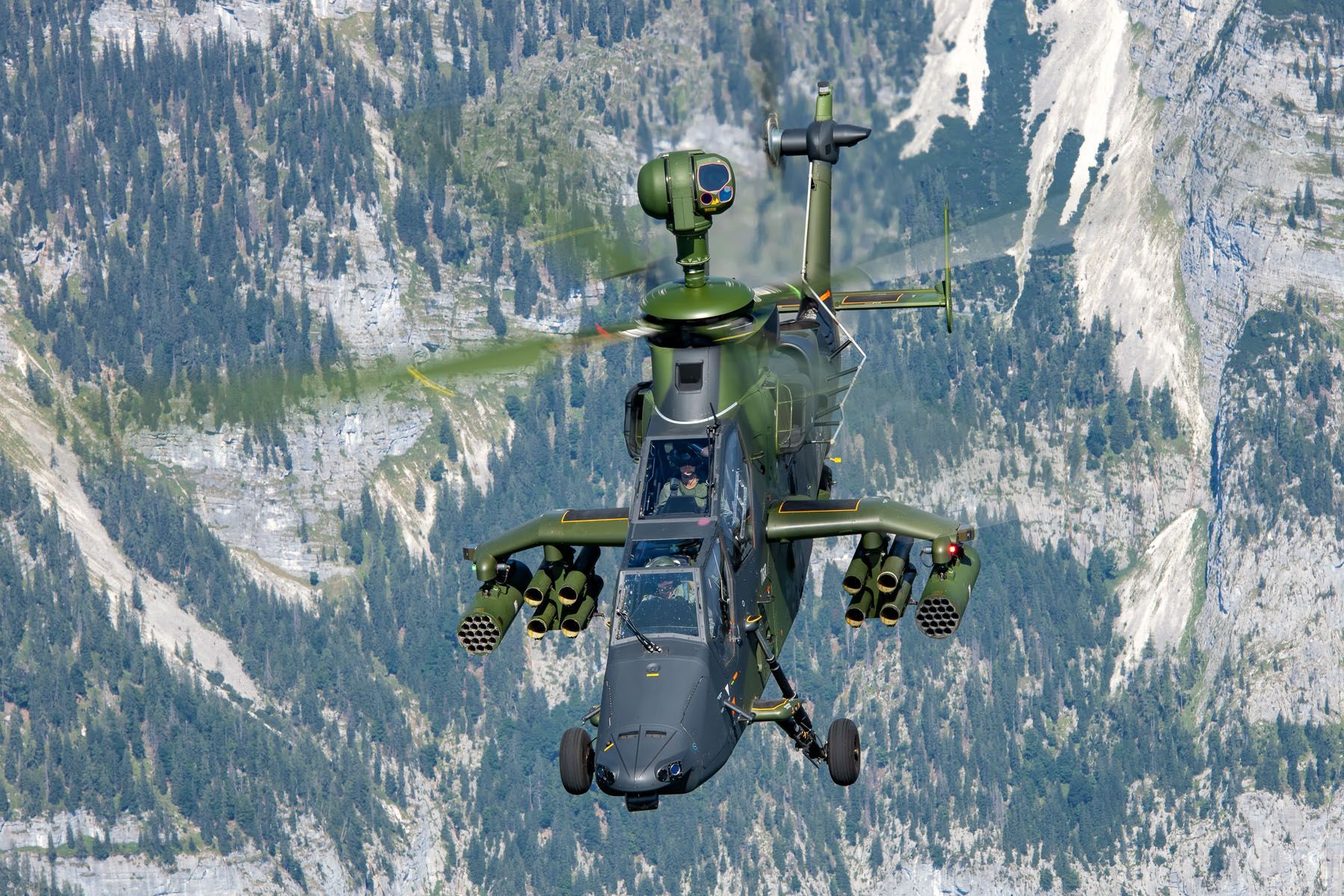
German Deal
As described before, the German Army referred to the helicopter as UHT (Unterstützungs Hubschrauber Tiger) to emphasize its armed support role. Nevertheless, the Amt für Heeresentwicklung (Office for Army Development) decided to change its designation into KHT (Kampf Hubschrauber Tiger) in October 2013.
At around the same time, some 35 had now been delivered to the German army. Most of these were in use with KHR 36, the operational regiment. Five were based at Le Luc-Le Cannet for crew training, two for ground instruction at Fassberg, and another pair was available for testing by WTD 61.
Reviewing its defence spendings, Germany reconsidered several programmes including the struggling Tiger, with too few operational at any one time. The order was renegotiated and on 10 June 2015, an amended contract was signed with NAHEMA (NATO Helicopter Management Agency). In the so-called ‘German Deal’, the order for 80 was reduced to 68. Part of the deal was a buy-back of 11 older airframes by Airbus Helicopters, however this condition was apparently changed at a later stage, as these were kept by the Bundeswehr for harvesting spares. On the short term, the effect was still minimal. While 43 KHTs had been delivered by December 2015, reportedly only six were combat ready.
As published in the 4. Rüstungsbericht der BMVg (4th Armaments Report of the Federal Defence Ministry) in 2016, a decision was made to upgrade 33 additional Tigers to the ASGARD variant. This modification would be spread over a number of years, with the last one expected to be finished in 2026.
The last of 68 Tigers was handed over by Airbus Helicopters to the Bundesamt für Ausrüstung, Informationstechnik und Nutzung der Bundeswehr (BAAINBw – Federal Office of Bundeswehr Equipment, Information Technology and In-Service Support) on 25 July 2018. Still, the in-service number would be reduced. By 2025, only 51 KHTs remain in active service, both operational and for flight training. Others are used for various ground training purposes, while three were involved in accidents.
It is noteworthy that the 68 Tigers delivered to the Bundeswehr carry serial numbers 74+01 to 74+70. Airframes 1033 (to be 74+33) and 1039 (future 74+39) have never been delivered. It seems that these two encountered technical issues in the production process to such an extend that both were not accepted by the client. The airframes were later scrapped by the factory.
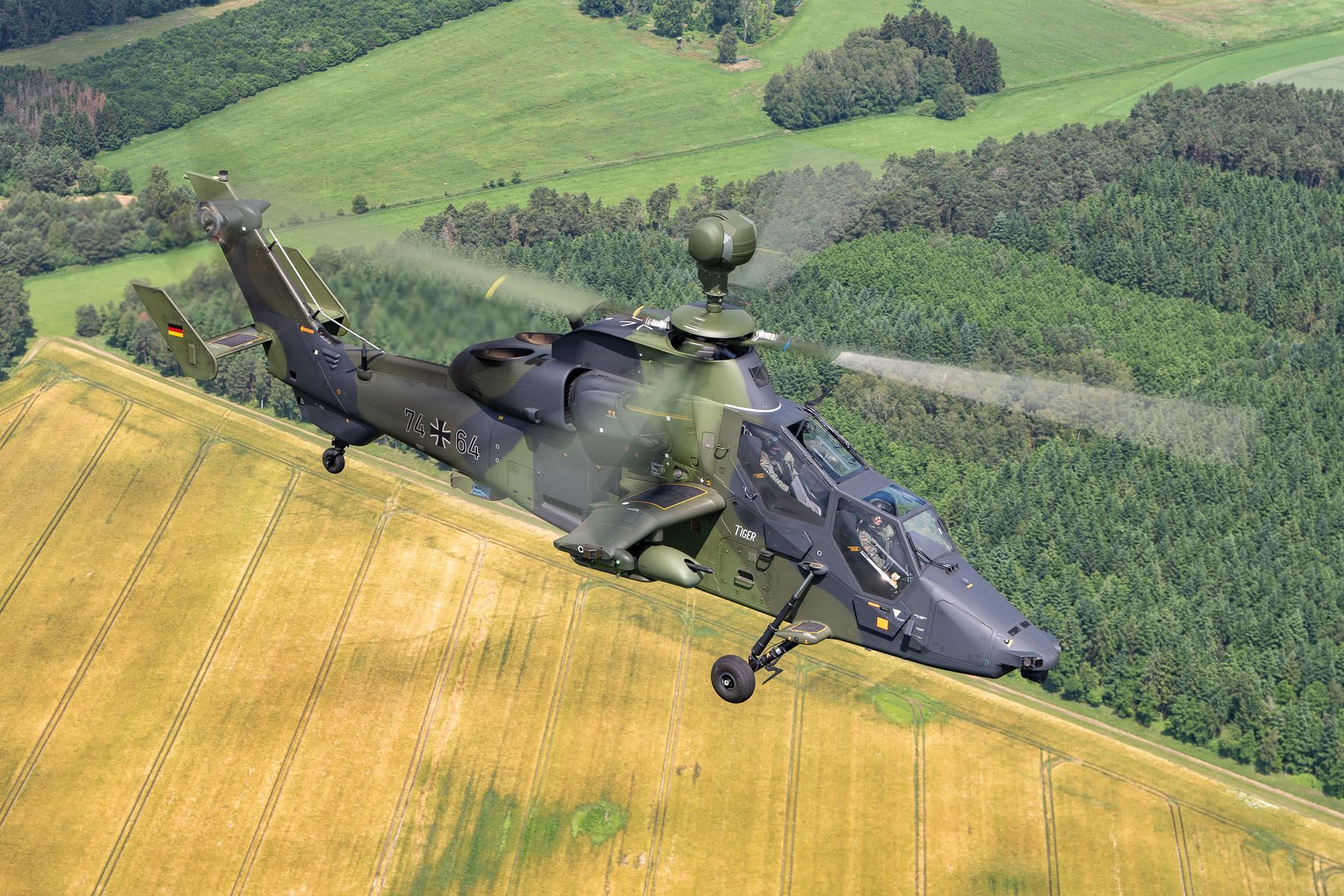
Heeresflieger Tiger Units
After completion of the basic helicopter flying course at the Internationale Hubschrauber Ausbildungszentrum (IntHubschrAusbZ – International Helicopter Training Centre) located at Bückeburg, assigned crews will receive a conversion course for the Tiger. This syllabus takes place in France at Le Luc-Le Cannet, under the responsibility of the IntHubschrAusbZ. Several KHTs are operated by the Heeresfliegerausbildungszentrum Tiger at this location, alongside two flight simulators. More simulators are available at Fritzlar, the main operating base.
Although the pilot and weapon systems operator each have dedicated roles, they are trained to take over from each other if required, in for example an emergency.
All combat operations with the Tigers are concentrated within the Kampfhubschrauberregiment 36 ‘Kurhessen’ (KHR 36 – Attack Helicopter Regiment 36) based at Fritzlar in Hessen, Central Germany. The regiment’s mission is to provide armed aerial support when required, to both regular and special operations forces. Beside this, KHR 36 can carry out liaison and observation flights, collect and supply battlefield data via datalink as an integrated sensor asset within a theatre-of-operations, or supply support during disaster and humanitarian relief missions.
A bit of unit history. KHR 36 was originally established as Heeresfliegerregiment 36 (HFR 36 – Army Aviation Regiment 36) in 1979 and equipped with some 60 MBB-Bölkow Bo 105P helicopters, operating alongside two other regiments being HFR 16 at Celle and HFR 26 at Roth. Initially reporting to the III. Korps in Koblenz, HFR 36 transferred to the Luftmechanisierten Brigade 1 (Air Mechanized Brigade 1) at Fritzlar in 1994, which itself was renamed to Luftbewegliche Brigade 1 (Air Mobile Brigade 1) in 2007. Meanwhile in 2002, HFR 36 was renamed KHR 36. Together with KHR 26, both regiments were destined to get the Tiger as Bo 105 replacements. The first three Tigers were taken on charge by KHR 36 in April 2011. Eventually, only Fritzlar would receive these helicopters as KHR 26 disbanded in 2014 while the base at Roth closed without ever operating the new hardware.
Today, KHR 36 consists of seven Staffel (squadrons). Two of these (2. & 3. Staffel) are the flying elements and known as KHT Einsatzstaffel 1 and 2, respectively; the other five serve in various maintenance and other support roles.
Along all rotary wing elements of the German Army, KHR 36 is part of the Kommando Hubschrauber, established in March 2021 and based at Bückeburg. This Helicopter Command reports to the Division Schnelle Kräfte (Rapid Forces Division), a joint German-Dutch unit that was created on 1 January 2014 by joining the Division Schnelle Operationen and the Division Luftbewegliche Operationen (Rapid Operations and Air Mobile Operation Divisions).
To prepare for its missions, KHR 36 has a simulator centre available. A large variety of realistic scenarios can be offered to prepare crews for their missions.
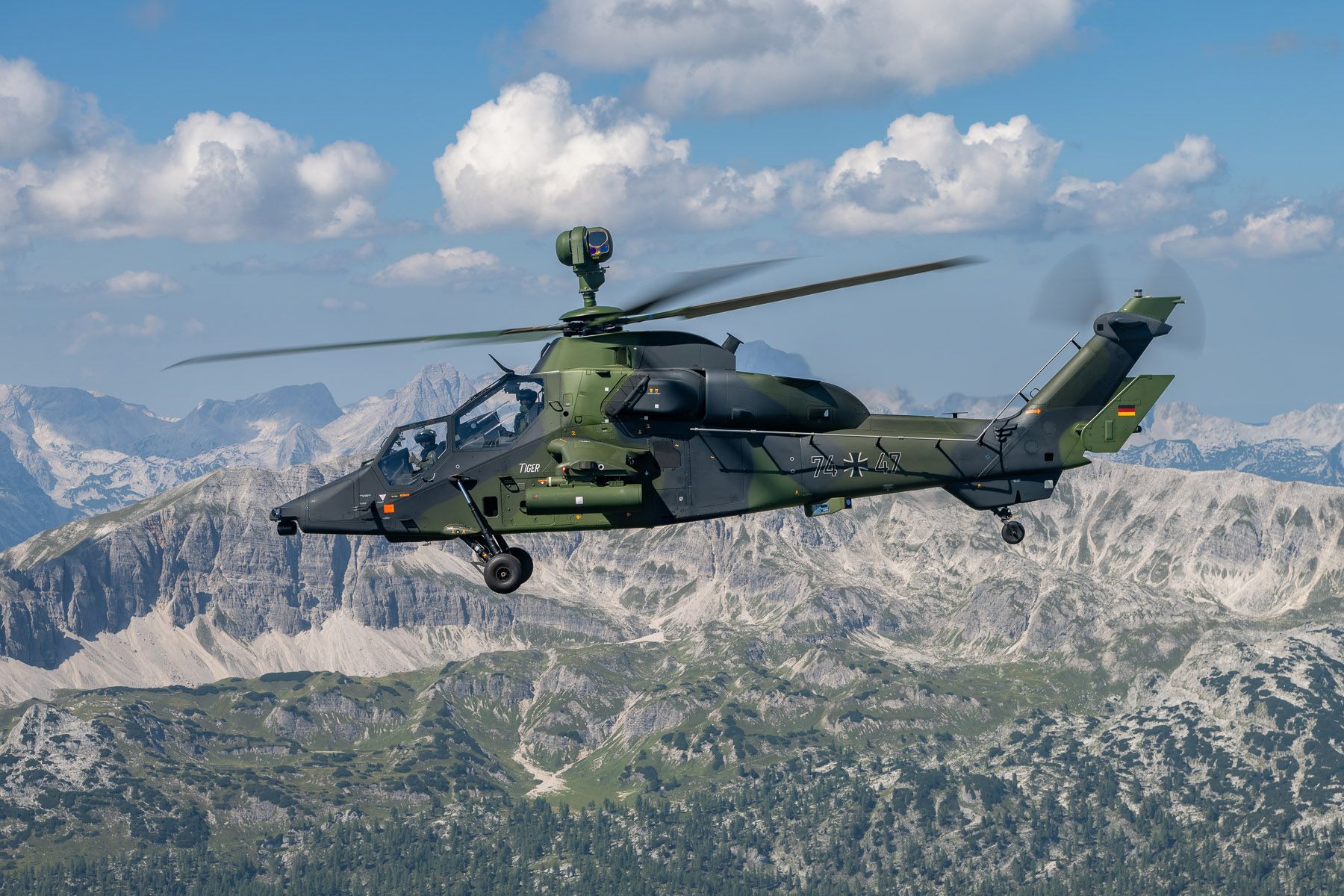
International operations
Over the years, KHR 36 has deployed to both Afghanistan and Mali. Four upgraded ASGARD-F Tigers were based in Afghanistan from December 2012 till June 2014. Two were ferried on 13 December 2012, the other pair followed seven days later. These were operated by the Einsatzgeschwader Mazar-e Sharif. This temporary unit controlled several German air assets from May 2006 in support of NATO’s International Security Assistance Force (ISAF) mission, and was eventually withdrawn early 2021. On 4 May 2013, a pair of Tigers successfully supplied air support for a group of Kommando Spezialkräfte (Special Forces Command) personnel that was ambushed. The Afghan KHT deployment ended officially on 30 June 2014, and the last helicopter returned to Germany one month later, on 29 July.
During 2017 and 2018, four Tigers were deployed to Mali in UN operation MINUSMA (Mission multidimensionelle Intégrée des Nations Unies pour la Stabilisation au MAli), with the goal to stabilize the northern part of this African country. Along with four NH90s, four Tigers were dispatched to Gao. The first pair was airlifted by an Antonov 124 on 21 March 2017, followed by the first operational mission on 5 May. The last mission occurred on 15 June 2018.
Exercises abroad are conducted every now and then as well. For example, in May 2024 KHR 36 participated in exercise Grand Quadriga in Lithuania, where units of the German Panzerbrigade 12 were supported. While operating from a Forward Operating Base, the Tiger crews were directed by JTAC officers to counter the simulated threats; a typical example of the regiment’s operation.
While in the past, the German Army had to rely on external assets to transport their helicopters, today the Airbus A400M is available to get that job done in case the ferry flight is considered too long or impracticable.
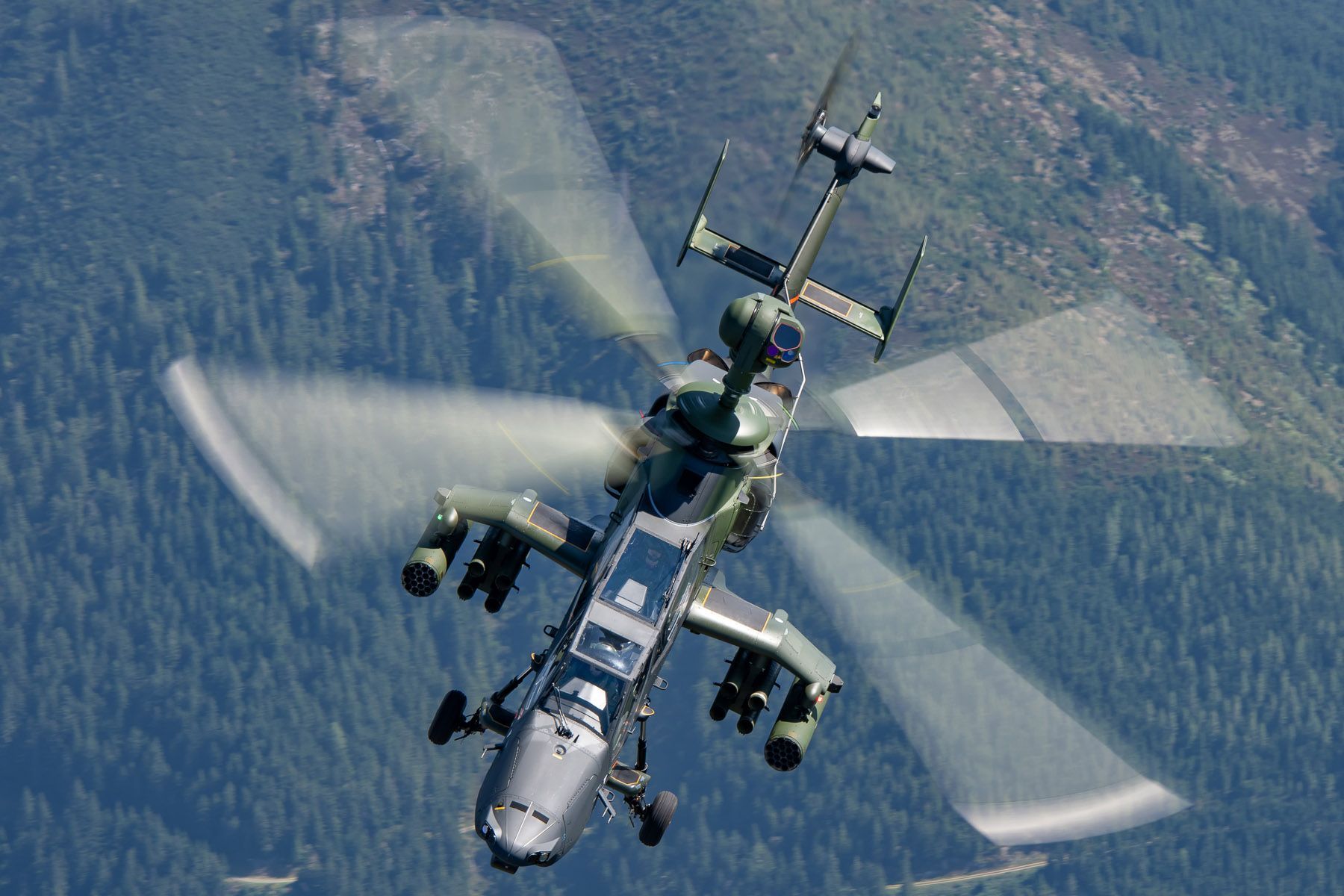
Mishaps
Unfortunately but sometimes inevitable in a high-risk environment, aircraft are involved in incidents or worse. The first loss of a German Tiger involved an ASGARD-T upgraded example (serialled 74+27) that crashed on 4 March 2013 near the Linderhof Castle in southern Germany. The accident happened during a training flight from Laupheim – a German air force helicopter base – in preparation for the crew’s deployment to Afghanistan. Fortunately, they escaped with minor injuries, but the helicopter was destroyed in the post-crash fire. A temporary flying ban was lifted a few days later.
The crew of a Mali-based Tiger in relation to MINUSMA was less lucky. Their helicopter (74+29) suddenly crashed in northern Mali on 26 July 2017, leaving no chance of survival. Following a thorough investigation, the cause of the accident turned out be shocking. Airbus technicians had committed maintenance to the helicopter at Fritzlar in May 2016, during which the main rotor control was adjusted incorrectly. During the ill-fated flight, this caused a sudden tipping of the helicopter as the autopilot directed the helicopter to the ground and then disconnected, leaving no time for the surprised crew to recover while encountering large negative g forces. Although the root cause was technical, the investigation resulted in certain restrictions of the use of the autopilot.
A third Tiger (74+48) was damaged on 8 November 2023 during a flight from the German-French training centre in Le Luc-Le Cannet. It struck a high-voltage power line southeast of Viens and thereafter landed in a field. The crew was unharmed but the damage to the helicopter was assessed as substantial. Given the early retirement of the type, a full repair might turn out to be too costly.
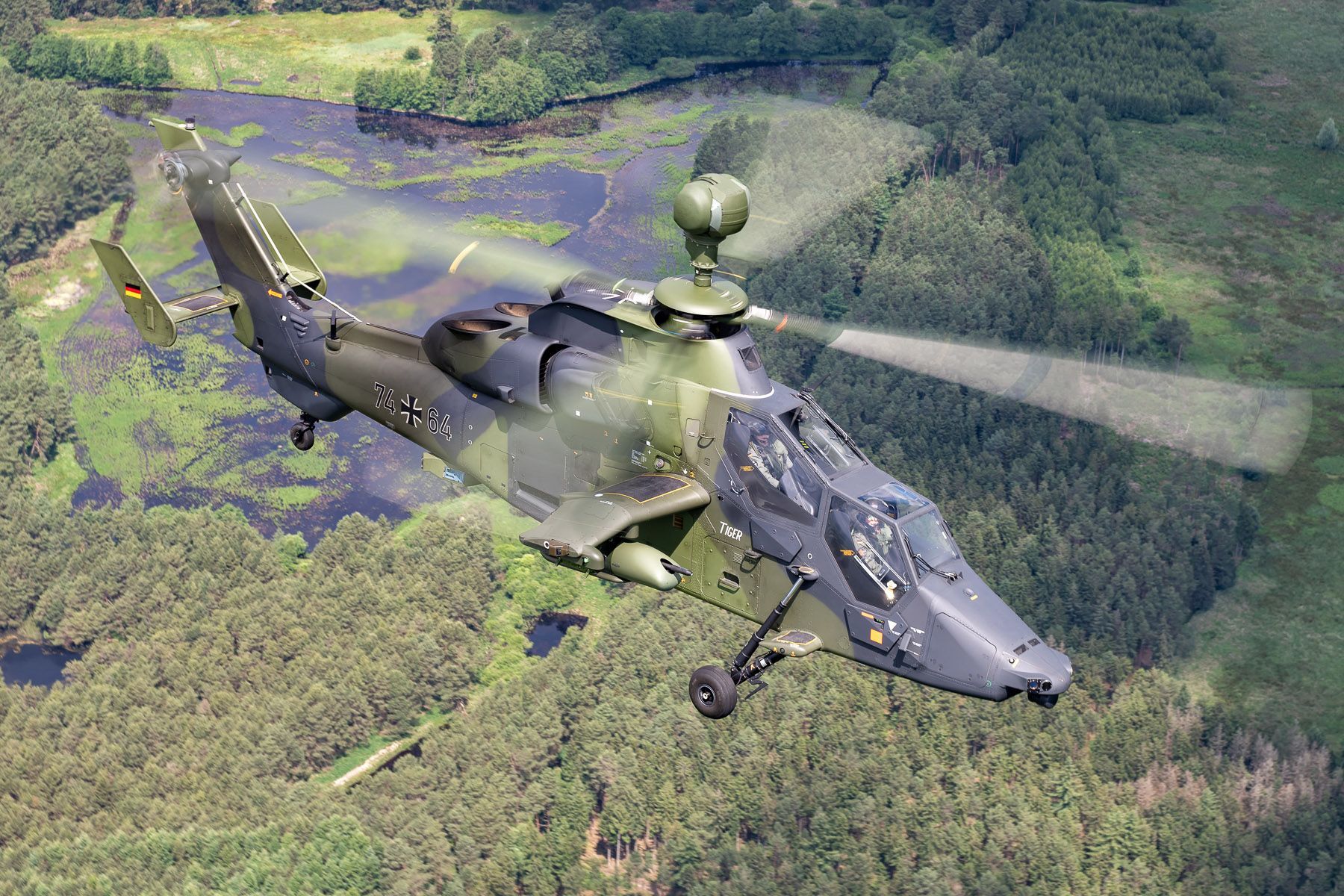
Early retirement and replacement
In 2023, France and Spain, the two other European Tiger operators, agreed on the Tiger Mk III project to modernise their fleets. As Germany decided not to participate in this programme, the future for the German Tigers already looked uncertain. The Defence Ministry – apparently unhappy with the helicopter for a long time, citing low levels of operational readiness and lengthly maintenance issues – regarded the Mk III upgrade as too expensive while development would take too long. Soon after, the axe fell. In May 2023, the decision was made to ditch the whole Tiger fleet by 2038 and to replace it with an interim solution, until a suitable platform would be selected and acquired at a later stage.
To the surprise of many, this temporary fix was unveiled with the announced acquisition for Airbus Helicopters H145M multi-purpose helicopters. The order for 62 H145M LKH (Leichte Kampfhubschrauber – Light Attack Helicopter) in a contract worth €2.1 billion was approved by the German parliament on 13 December 2023, with an option for 20 more.
The decision to replace the Tiger with the H145M has been criticised within the armed forces, as although a versatile platform, the new helicopters can’t be regarded as a suitable replacement due to its limited firepower, protection, speed and range when fully loaded. This could negatively effect German’s defence capabilities, also in view of NATO commitment. According to Defence Minister Boris Pistorius who visited KHR 36 in September 2024, “despite being [the H145M] an interim solution, the new helicopters will have many advantages because of their large capacity of reconnaissance and wide range of armament.” It will probably take some time and effort to convince the specialists in the field; time will tell.
The H145M LKH is expected to enter service with KHR 36 from mid-2026 when the first of 24 will arrive. The IntHubschrAusbZ at Bückeburg received the first of 23 on 20 November 2024, to commence crew training. Other units receiving these new helicopters will be Hubschraubergeschwader 64 of the Luftwaffe (five from late 2025 to expand their existing fleet of H145M LUH SOF); Transporthubschraubergeschwader 10 (five from March 2027) and THR 30 (also five, from February 2028) to operate alongside their NH90s. The last H145M LKH is expected to be delivered by 31 July 2028.
The Tigers will now gradually be phased out. In the so-called 18. Rüstungsbericht published early 2024 by the Defence Ministry, it is mentioned that by 2028, the fleet will be reduced to 33 helicopters. Of these, at least 24 will be ASGARD-configured examples. The airframes to be retired will be used for spare parts, or so-called Hochwertteilgewinnung. Although it was announced in May 2023 that the type’s retirement was foreseen for 2038, the final example will now leave service early 2033 according the mentioned defence paper.
So, can the German Army do without dedicated attack helicopters? The war in Ukraine has showed that these helicopters can be quite vulnerable, with the Russians having lost many. However, one could discuss that if the battlefield is completely different, with air superiority covering their backs, attack helicopters could be far less prone to counter attacks. Reportedly, the German Army would prefer to continue operations of their KHTs for some more years. But given the fact that the PARS 3 LR and HOT-3 missiles might no longer be available in a few years, this would make the Tiger less significant anyway. Soon, the H145M LKH will lead the business, and hopefully it will never have to prove itself in combat over Europe. Still, be prepared. ■
